Gunther Variations: 1947-1950
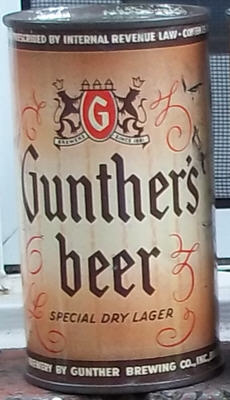 |
 |
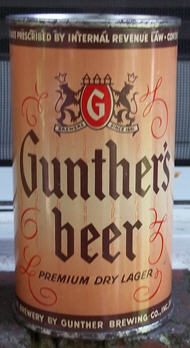 |
Can #1 |
Can #2 |
Can #3 |
One of the brands I especially like to collect is Gunther from Baltimore. I've covered several other Gunther cans before (see list below) but I have not yet covered these Gunther Beer cans sold just after World War II, and they're some of my favorite labels.
The three cans here are displayed in chronological order. I used the American Can Company dating codes to place them in the correct order. Note that Cans 1, 2 and 3 all are IRTP, that is, they have the tax statement required by law on beer labels until March 1950.
Can #1 has the second date code for 1946 on the side. Beer cans were not available for civilian use until early 1947, but can companies were allowed to start making some beer cans in late 1946 in preparation This can is a tough variation to find because the front reads "Special Dry Lager" whereas the others say "Premium Dry Lager." Since this can is difficult to find it was probably a short lived label. This can also has an earlier style bottom lid and an older style seam, which helps confirm that it predates the following cans.
|
 |
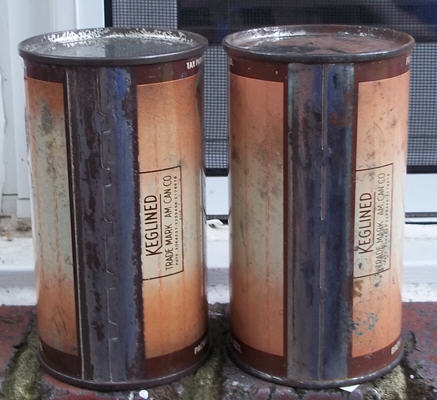 |
The older seam is to the left. It has more "teeth" than the newer seam at the right. |
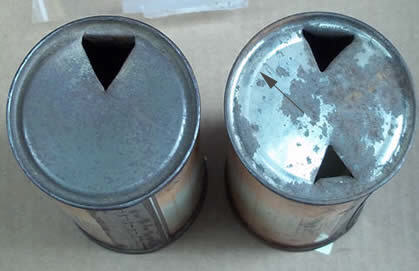 |
The older lid is at left. Note how the lid on the right has a raised ridge along the edge that is lacking on the older lid (see arrow). This ridge was added to lids in the 1930s. It was added to the bottoms in about 1947-48. |
| Can #2 is dated 1947. Now the label reads "Premium Dry Lager." There is also a more subtle change. This label series usually includes faint vertical red lines in the background. On this can, however, the lines do not extend below the words "Premium Dry Lager" whereas they extended all the way to the dark brown strip at the bottom of the can on the previous label. Then these faint lines reappear on the next two cans. Why drop the lines for this variation and then re-add them? Let's look at the next can and I'll take a stab at figuring out why. |  |
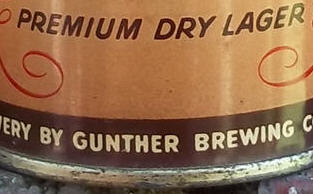 |
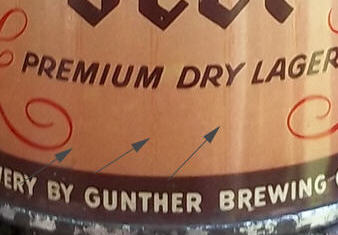 |
| Here is a close-up of Can #2. The area under the words "Premium Dry Lager" is blank. | Here is a close-up of Can #3. The area under the words "Premium Dry Lager" have the faint vertical lines (I marked some with arrows). |
Can #3 is dated 1948, and the faint lines have returned between the words "Premium Dry Lager" and the dark brown line at the bottom. Why restore the lines? I don't think the change really changed the balance of the design that much. My theory is that the lines were accidentally deleted in 1947. Perhaps when the graphic artist--probably at American Can Company--changed "Special Dry" to "Premium Dry" they also accidentally erased the faint lines in that portion of the label. Both cans were made by American Can in their New York City plant (there is a plant code by the date code) so the "missing lines" are not the common variations you may see in cans made at the same time by different companies or at different plants. Also, the lines were never removed from the bottle labels, which further suggests that their removal from the can label was an error. The lines were reinstated within a relatively short time. Note that nothing else changed in the design from Can #2 to Can #3 so reinstating the partial lines was not part of a larger design change. (FYI, I have another of the same can dated 1949).
|
 |
Can #4 is the post 1950 can. The tax statement at the top was replaced with "Packed at the Brewery by Gunther Brewing Co., Inc., Baltimore, MD." That used to be on the dark brown bottom band on the IRTP cans. On this can the bottom band reads "Brewers of Maryland's Famous Dry Beery Beer * Contents 12 Fluid Oz's." This is a more substantial change to the label, or at least a less minor one, and I would have expected this variation, not the earlier one, to have been when they restored the lines missing from Variation #2. This suggests that either restoring the lines was an easy change to make, or that the lines were a really important part of the design. I tend to think it was the former. BTW, this can has the production date code for 1949, no doubt being made in anticipation of the March 1950 law change which removed the "Tax Paid" statement from labels. |
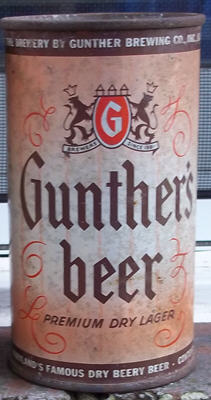 |
A Timeline: 1946-1950
So, what happened to the Gunther label from 1946-1950? Here is my suggested timeline. Please note that because I do not know how long it took to design and produce a new label, that these dates are based upon the production codes on the cans themselves.
Late 1946: In anticipation of the return to civilian canning in early 1947, Gunther Brewing orders a new batch of cans with the then current label design with "Special Dry." The cans are produced in late 1946 using the older bottom lids and seam construction.
1947: Gunther decides to change the label on their cans and bottles to read "Premium Dry" rather than "Special Dry", perhaps to reflect the popular usage at the time for "Premium." At this time the background line at the bottom of the label are deleted accidentally. The cans have the new bottoms and seams.
1947-1948: Gunther reorders a new shipment of cans and the lines are restored. I imagine the conversation could have gone something like this.
Gunther Rep: We'd like to order a new shipment of 12 oz cans for our beer.
American Can Rep: OK, are you happy with the current design?
Gunther Rep: It's fine, but the designer dropped the background lines on the bottom part of the label the last time. Can you fix that?
American Can Rep: Sure, no problem. Should be an easy fix. We'll send a new proof over for you to see before we start production.
This is just my guess, but it seems to fit what facts I have. The new cans were then made with the "corrected" label.
Late 1949: Gunther orders more cans without the tax statement. The lines remain. This can design is in use from 1950-1951 when the label undergoes a more drastic change.
1951: Another label change ends this series of cans.
1952: Gunther undergoes another design change.
1955: Gunther introduces their last label change.
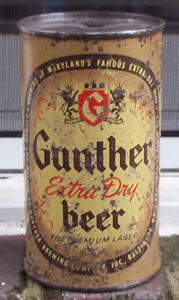 |
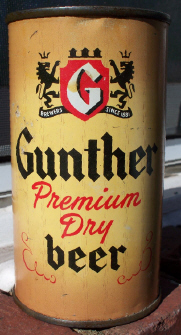 |
The 1951 label. |
Alternative Suggestions?
My theory of why the design change occurred fits the available evidence (I think) but I may be wrong. Consider this alternative scenario.
Perhaps when "Special" was dropped in favor of "Premium" the faint background lines at the bottom were dropped because it was thought that they distracted from the new word "Premium." The brewery or designer (or both) wanted the word "Premium" to stand out more, and though that it would do so against a blank background.
After a year or so the lines were returned because either
a) they felt that customers had enough exposure to the new "Premium" emphasis,
b) they decided that the lines did make the can look better, or
c) that THIS (restoring the lines) was the error, not deleting the lines as I suggested above.
The problem with this hypothesis is that the bottle labels did not drop the background lines. Unless they were left on the bottle label by accident, which is possible but would indicate a very sloppy proofreading process, the fact that the bottle labels always had the background lines strongly suggests that my original idea, that the lines were dropped by accident from the 1948 can design, is the correct one.
My Other Gunther Pages
Gunther Racetrack Can (1955-1960)
Sources Used
The American Can Code list. Discovered by Bob Porter, these codes are an invaluable tool for those researching beer cans from 1935-1954.
Bob Kay. US Beer Labels, 1950 and Earlier. Vol. 2: East & Southern States. Check my page on Bob's label books for more information. Thanks to Bob for answering my questions about Gunther bottle labels.
